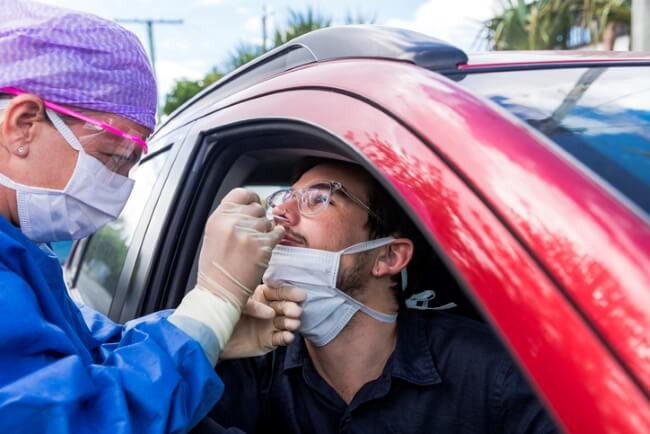Microfluidic Technology May deliver Cheap, Easy Coronavirus Test
| 08-04-2020 | By Rob Coppinger
Testing is an important part of the World Health Organization’s strategy for defeating the global pandemic of the new coronavirus and microfluidics, also known as a lab-on-a-chip, could be the technology to deliver the cheap, easy test that everyone worldwide can use to produce a reliable result.
How can Microfluidics be used in the Coronavirus Pandemic?
In a microfluidic device small enough to fit on a patient’s palm, a biological sample travels through etched channels and into tiny compartments where it reacts with chemical reagents. Microfluidic devices, which can be made from a polymer or glass, silicon, metal or other materials have these channels and compartments which are divided into the functions of reactor, mixer and detector. These devices allow tiny volumes, measured in microlitres, of a patient’s sample to be handled precisely. A microlitre is one thousandth of a millilitre.
There are two types of test for coronavirus. One uses blood and looks for antibodies created by people that have had the virus and built up an immune response. The second looks for the virus’ nucleic acids, which can be deoxyribonucleic acid (DNA) or ribonucleic acid (RNA), to confirm that a patient has the virus. RNA is a nucleic acid that acts as a messenger carrying instructions from DNA for controlling the synthesis of proteins.
Researchers at Purdue University in Indiana are designing a microfluidics device for that second test. For a coronavirus, the testing process begins with a sample being taken from a patient’s nasal passage with a swab. The first stage of testing that swab sample is to amplify the DNA or RNA that was obtained from the nasal passage. Amplifying the DNA or RNA means increasing the quantity of genetic material to improve the chances of the test being accurate. “Without internal amplification control you would have a lot of false negatives,” said Purdue University biomedical engineering assistant professor, Jacqueline Linnes. The false negative would occur because the device would not be able to see the original small amount of DNA or RNA.

To control the flow of the sample through a device, researchers at Purdue have employed heated wax valves for fluidic control in their microfluidic rapid and autonomous analysis device (microRAAD). The heating elements temperature reaches 80 degrees Celsius. The Purdue team’s microRAAD uses a battery powered temperature control circuit for its heat activated wax valves and to regulate the temperature of the device in key sample processing areas. The heat activated wax valves are opened to allow the patient’s sample to move along from one stage to another, for example, to a flow detection strip.
The chemical reagents the sample reacts with in the device’s tiny compartments, the reactor, for example, contain what are called primers. Primers are substances, such as deoxynucleotide triphosphates, which help DNA duplicate itself; to increase that quantity of DNA, to amplify it. Because the volumes are so small in the reactor, reagents that are potentially toxic or explosive can still be used. And with these tiny volumes, reactions can be faster and more efficient because they are performing chemical and biochemical processes at scales of just micrometres. Another advantage for microfluidic detection over other tests is the reduced risks of contamination due to the testing device being small.
Linnes and her fellow researchers have created dry reagents for their device. Dry, not liquid, reagents are more easily stored and shipped to the clinical staff that need them. The Purdue team is working on a coronavirus capable microfluidic device and for this the reagents and their primers must be redesigned to match the virus; or any other virus they are to be used for. The new reagents will still be dry for that ease of storage and shipping. Linnes explained that: “primer redesign [for coronavirus] is something which is ongoing. Some people have published work on primers for coronavirus already.” How the patient’s sample is prepared for the microfluidic device also has to change.
While the reagents will change, the microfluidic platform, whether it is silicon or glass, is expected to stay the same. "We are adapting our technology. We are focusing on the platform and they are focusing on the chemistry [for coronavirus]," said Linnes, referring to a biotech start-up Linnes and her fellow researchers have been in talks with since the end of 2019. The final results from microfluidic testing are displayed by a colour change along a small piece of treated paper that forms part of the device.
This colour change can be accurately interpreted automatically by a mobile phone application using a photo detector which is part of the microfluidic device and can detect the colour changes. This mobile phone app analysis is a possible evolution of a microfluidic device and is not being used by Linnes’ team’s device. The mobile phone could also provide power, instead of the lithium-ion battery which is part of the existing microfluidic device design.
The world needs a robust, portable, simple and easy to use test device for coronavirus which is a novel virus that is here to stay with all the deadly implications that it has. Microfluidics and future versions of microRAAD could be the answer to providing humanity with a defence against this lethal disease.
